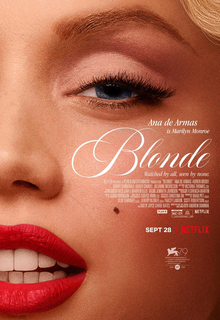The Butchering of Marilyn Monroe Biopic, “Blonde”

The interpretation, or misinterpretation, of Marilyn Monroe in Andrew Dominik’s recent biopic, Blonde, does not live up to expectations. Originally viewed as one of the most highly anticipated films of the year, with advertisements and images promising a new awareness and understanding of Monroe, the NC-17 rated movie took a complete 180 in reviews. While lead Ana De Armas does manage to capture the famed star, the film itself disappoints, saturated with unnecessary hypersexualization.
The movie is, overall, a convoluted compilation of crude visuals better left unseen at the risk of triggering emotional trauma. The film profits off of the 1950s misogynistic sexualization of women in film, a grotesque misconstruction of reality that is absurd in 2022. Netflix’s Blonde proves Marilyn Monroe is still waiting for someone to truly represent her.
This largely out of touch film spans Monroe’s life from age 7 to her mid-30s, focusing on the Hollywood icon’s rise to fame as well as her private life. At its core, the movie boils down to a shallow film disguised as a visually appealing compilation of an icon’s private struggle. Director Andrew Dominik in his vision of the film wildly oversimplifies the psychology of “daddy issues,” and even includes the shocking capture of Monroe shaking as she leaves a film studio president’s office, trembling and numb as she seemingly detaches from herself after being sexually assaulted.
Dominik transforms Monroe’s life into a series of sexual “mishaps” and utterly overlooks her influence and reach in mainstream media and culture. The only semblance of character development she undergoes is sexual liberation (which blurs the line of exploitative grooming), yet she is never given proper autonomy or control. With little substance in the script, viewers also lack any understanding of Monroe’s emotional depth and thought process as she is thrown from director to director.
Fueling the misinterpretation in the film is the concept of Marilyn Monroe as a “sex symbol,” something inherently toxic. The very idea of attaching the notion of “sex symbol” to icons has led to the practice of objectification and transforming ideas of beauty. What must have started as an acknowledgement of attributes in cinema sprouted into a highly poisonous stereotype, the bulk of which mainly fell on women. The film industry is perceived as a space of compromise and progressiveness, yet the media ultimately consumed is a result of hypermasculine expectations of women. This furthers the idea of what constitutes as sex appeal in women, which can lead to the inception of harmful methods of intermittent fasting, not eating for days, anorexia, and surgeries just to fit this pointless blueprint set by out-of-touch executives. Particularly in the 1950s, an actress’s human identity was often shaped by the public nature of the profession and the display of body it entailed for women. Monroe’s case has become one of the quintessential examples in popular media in exhibiting the sexualization of an actress’s entire identity, and the resultant exploitation. The film evokes a narrative of victimhood and reduces Monroe to a two-dimensional character, a mere reflection of her sexual potential and experiences.
Another insensitive trope in the movie is the theme of motherhood and childhood trauma. Abused by her mother growing up, this theme returns to play an essential part in the second half of Blonde. Blonde depicts a controversial take on Monroe’s abortion for her child with Charlie Chaplin Jr., and then displays how Monroe is sexually exploited by the president and hallucinates having another abortion. Meant to show how Marilyn suffers from mother’s guilt that, by the end of the movie, supposedly engulfs Monroe, driving her into insanity, the storyline is completely offensive and out-of-touch.
Even though her contributions were often overlooked, Monroe worked relentlessly for social and humanitarian causes, often providing much-needed entertainment through her performances to military troops in Korea. These philanthropic events are not even remotely featured in Dominik’s adaptation. Overall, Blonde horrifically displays Marilyn Monroe, tragically memorializing the multi-dimensional icon as little more than a sex symbol, remembering her only for the atrocities she suffered, instead of her many triumphs.
Sources:
https://dbknews.com/2022/09/30/blonde-movie-review-marilyn-monroe-netflix-biopic/
https://www.filminquiry.com/blonde-2022-review/
https://feminisminindia.com/2022/06/02/marilyn-monroe-and-the-sexist-idea-of-sex-sym

Lucy, a sophomore, hopes to expand her journalistic horizons as she enters her second year writing for the Banner. In her free time, she indulges in hours...


